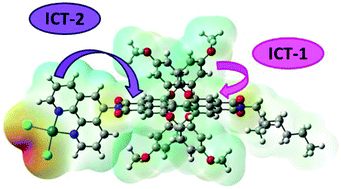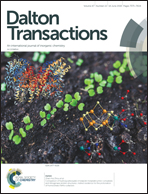Syntheses and studies of electron/energy transfer of new dyads based on an unsymmetrical perylene diimide incorporating chelating 1,10-phenanthroline and its corresponding square-planar complexes with dichloroplatinum(ii) and dichloropalladium(ii )†
Abstract
Perylene diimides (PDIs) are among the most versatile and functional dyes for supramolecular structures displaying characteristic high absorptions and photo-luminescence properties as the prerequisite for optoelectronic thin film devices. Despite intense investigations into these semi-conducting and electro-active materials, details of their electronic structure are still under examination. In particular, non-planar twisted PDIs as an electron acceptor is a promising model system for efficient charge generation and transport processes. Therefore, a new dyad, an unsymmetrical PDI, N‘-(2-ethylhexyl)-N‘-(1,10-phenanthroline)-1,6,7,12-tetrakis-(4-methoxyphenoxy)-3,4,9,10-tetracarboxylic acid diimide (1) and its corresponding dichloroplatinum(II) and dichloropalladium(II) complexes as new dyads, [(Cl2)M(II)-(1)] where, M(II) = Pt(II) (2) and Pd(II) (3), were prepared. These dyads were fully characterized by FT-IR, 1D-NMR (1H-NMR and 13C-NMR), 2D-NMR (1H–1H COSY, 1H–13C HSQC, 1H–13C HMBC), MALDI TOF mass and UV-Vis spectroscopy. Electronic structure calculations have been employed based on Time-Dependent Density Functional Theory (TDDFT) calculations for the geometry-optimized electronic ground state structures in the gas phase and in dichloromethane (DCM). Current results indicate that 2 and 3 have similar HOMO–LUMO energy gaps which are smaller than 1. The energy and charge transfer processes with molecular structures are crucial for the design of future functional dyads based on donor and acceptor moieties for hybrid optoelectronic devices. Charge transfer mechanisms were also investigated with linear absorption, fluorescence and ultrafast transient absorption spectra for the newly synthesized compounds in DCM. The observed ultrafast intramolecular charge transfer from donor units on the PDI-2 compound is related to fluorescence quenching and faster singlet decay on transient measurements.



 Please wait while we load your content...
Please wait while we load your content...